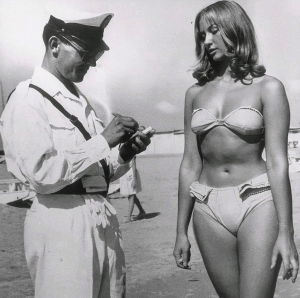The Women Who Dared to Bare – The Bikini’s Rise to Power
On a sweltering summer day in 1946, on the edge of a Parisian pool, a young dancer named Micheline Bernardini stepped into history. Dressed in what was then considered a scandalous amount of exposed skin—a two-piece garment held together by a few strings and a whole lot of daring—she became the first woman to model the modern bikini. In that moment, the bikini was not just born—it exploded into the cultural consciousness like the atomic bomb it was named after.
From controversy to catwalks, from resistance to revolution, the bikini’s journey is as bold as the women who wore it. It’s a story of freedom, feminism, fashion, and fierce resistance to conformity—a testament to how much can be said with just a few inches of fabric.
A Bombshell Introduction: 1946 and the Bikini is Born
The name “bikini” wasn’t chosen at random. Designer Louis Réard, a French automotive engineer turned fashion innovator, debuted the two-piece swimsuit on July 5, 1946, just days after the United States conducted nuclear tests on Bikini Atoll in the Pacific Ocean. Réard hoped his creation would be just as explosive in impact—and he was right.
The reaction was immediate and intense. The bikini was banned in several countries, including Italy, Spain, and parts of the U.S. Churches called it immoral. The Vatican denounced it. Most models refused to wear it. Only a nude dancer like Bernardini, accustomed to baring all, would dare to step into the limelight wearing what was dubbed “smaller than the world’s smallest bathing suit.”
But the bikini could not be erased. It was provocative, liberating, and deeply symbolic of a post-war generation eager to shed restrictions and embrace a new, bold identity.
The Post-War Woman: Breaking Free of Fabric and Expectations
World War II had changed everything. Women had taken over roles traditionally held by men, proving they were capable, independent, and strong. After the war, as society attempted to stuff them back into domesticity, many women weren’t so quick to obey.
The bikini, in many ways, became a symbol of rebellion. It said, “I own my body.” It defied modesty laws, male expectations, and the rigid rules of fashion. It celebrated the female form not as something to be hidden, but as something to be proud of.
In conservative circles, it was seen as threatening. To feminists and free-thinkers, it was empowering.
Hollywood Embraces the Bare
Though initially shunned, the bikini found unlikely allies in Hollywood starlets. The 1950s saw the rise of bombshells like Brigitte Bardot, who famously wore bikinis in French Riviera films. Bardot’s on-screen confidence and off-screen defiance helped make the bikini a fixture in European fashion.
In the U.S., Ursula Andress catapulted the bikini into icon status with her unforgettable scene in the 1962 James Bond film Dr. No. Emerging from the ocean in a white two-piece, knife strapped to her hip, Andress became a pop culture legend. That one scene helped transform the bikini from scandal to sex symbol.
Other stars followed suit: Raquel Welch, Marilyn Monroe, and Goldie Hawn each used the bikini to express femininity and strength, helping shift public perception from indecent to desirable.
The 1960s and ’70s: Bikinis, Beaches, and the Sexual Revolution
The bikini didn’t just ride the wave of the Sexual Revolution—it helped make it possible. The 1960s brought with it civil rights movements, anti-war protests, and a generation of youth questioning every rule their parents had lived by. Bikinis became symbols of freedom, body positivity, and anti-establishment values.
During this time, surf culture boomed, and bikinis became the uniform of a sun-kissed, rebellious youth. Music, magazines, and TV all embraced the look. Songs like “Itsy Bitsy Teenie Weenie Yellow Polkadot Bikini” captured the playful tension of girls daring to break the mold.
By the 1970s, the bikini was fully mainstream—but still controversial. The feminist movement itself was divided: some saw the bikini as sexual exploitation; others saw it as a woman’s right to express her body as she pleased.
High Fashion and Body Power: The ’80s and ’90s
In the 1980s and 1990s, the bikini began to evolve. No longer just about rebellion, it became a canvas for high fashion and athletic power. Supermodels like Cindy Crawford, Naomi Campbell, and Elle Macpherson made bikinis glamorous. Meanwhile, sportswear brands began crafting suits for functionality as well as fashion.
Baywatch took the world by storm in the 1990s, with Pamela Anderson’s red swimsuit becoming an iconic image of the decade. It wasn’t a bikini, but it carried the same spirit: women who were powerful, confident, and in control of their sexuality.
This era also introduced the string bikini, thong bikini, and Brazilian cuts, pushing boundaries further and celebrating diversity in body shapes and styles.
21st Century: From Instagram to Inclusivity
Today, the bikini is everywhere—on Instagram feeds, fashion runways, and in cultural conversations about body image and inclusivity. Modern brands like Savage X Fenty, Aerie, and Summersalt focus on creating bikinis for every body type, moving away from the “ideal” beach body and toward radical self-love.
Social media influencers and celebrities continue to redefine what it means to wear a bikini. From Rihanna’s fierce style to Lizzo’s unapologetic self-love, bikinis have become platforms for personal expression, body confidence, and identity.
At the same time, debates continue. Are we objectifying ourselves? Are we empowering ourselves? The bikini continues to walk that fine line between expression and expectation—but maybe that’s its power.
The Women Who Dared: Courage in Fabric
The bikini’s rise to power is not just a story of a garment. It’s a story of the women who dared to wear it when the world said not to.
Women like Micheline Bernardini, who smiled confidently at photographers while the world gasped. Women like Brigitte Bardot, who walked Cannes beaches with no concern for judgment. Women like athletes, dancers, activists, and artists who used their bodies as declarations of freedom.
And everyday women, too—the mothers, daughters, and teenagers who stepped onto beaches for the first time, worried but determined. Every time a woman wears a bikini on her own terms, she becomes part of that legacy.
Conclusion: More Than Just a Swimsuit
The bikini is more than fashion. It’s resistance stitched in fabric. It’s a celebration of the human body, a challenge to outdated rules, and a declaration of autonomy. It has sparked outrage, inspired confidence, and shaped generations.
For every woman who has dared to bare—not for approval, but for herself—the bikini stands as a symbol of courage, evolution, and power.

